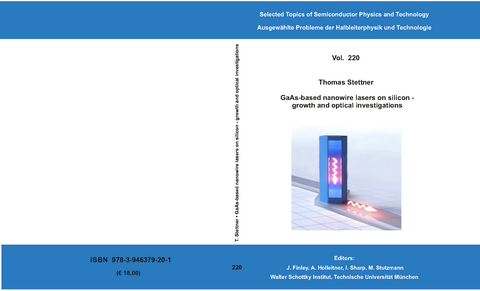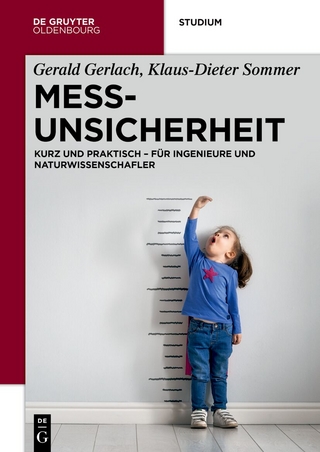
Ga-As-based nanowire lasers on silicon - growth and optical investigations
Seiten
2019
Verein zur Förderung des Walter Schottky Instituts der Technischen Universität München (Verlag)
978-3-946379-20-1 (ISBN)
Verein zur Förderung des Walter Schottky Instituts der Technischen Universität München (Verlag)
978-3-946379-20-1 (ISBN)
- Keine Verlagsinformationen verfügbar
- Artikel merken
Chip-scale integrated light sources have the potential to replace electronic components by photonic devices and thus contribute to the big challenges of limited speed and energy consumption in current data communication applications. III-V semiconductor nanowires (NWs) have demonstrated their potential as nano-scale lasers with their unique material and geometric properties, and the capability to be monolithically grown on lattice-mismatched substrates including silicon. However, the realization of such an integrated optical microchip is currently challenged by the realization of high-performance nanowire emitters and the integration on photonic platforms in the silicon transparent wavelength regime.
In this thesis, we investigate GaAs-based nanowire lasers epitaxially integrated on silicon. We use molecular beam epitaxy (MBE) to obtain high quality light emitters without the need of any foreign metal catalyst such as gold. In the beginning, we demonstrate the monolithic integration of individual GaAs-AlGaAs NWs onto Si ridge waveguides (WG) on a SOI platform. For this, challenges in site-selective core growth, nanowire yield and residual material layer on top of the WGs are addressed. Performing photoluminescence (PL) studies reveal lasing behavior from individual NWs and successful coupling of the lasing mode to the propagating WG mode exceeding propagation distances of > 60 µm. Supporting 3D finite-difference time-domain (FDTD) simulations show that coupling efficiencies of up to ~16 % can be achieved. Analyzing the propagation losses shows that the intensity decrease can be primarily attributed to high absorption losses in silicon at the emission wavelength of 830 nm from the GaAs NW lasers.
Consequently, the main part of this work is dedicated to the reduction of these losses by shifting the lasing emission to longer wavelengths. Ternary gain media, such as InGaAs offers bandgap tuning capabilities over a wide spectral range from 880-3500 nm. As a first starting point, the catalyst-free growth of InGaAs NW cores is studied, which revealed tremendous limitations in key parameters such as In-incorporation, crystal quality and aspect ratio. An alternative approach using vapor-liquid-solid (VLS)-grown GaAs NW cores as a template for radial InGaAs shells revealed substantial strain effects, suggesting the reduction of the material layer thickness and implementing quantum-confined active gain media. Integrating low dimensional structures such as quantum wells (QWs) in a NW allows to modify the material gain as a result of the step-like 2D density of states. After careful design, two optimized NW laser structures were grown, containing either a single 8 nm GaAs QW or a seven-period 8 nm GaAs MQW. Photoluminescence studies reveal lasing operation and emission energies confirming quantum confinement of the active QW material. A statistical comparison proves a ~7-fold threshold reduction for the MQW NWs compared to SQW NW lasers. Temperature-dependent investigations reveal that lasing prevails up to 300 K in the MQW NWs and an improved temperature stability. Ultimately, we demonstrate tuning of the lasing emission by varying the material composition in the InGaAs quantum wells (QWs) and study growth mediated effects on the material quality by correlated scanning transmission electron microscopy (STEM), atom probe tomography (APT) and PL spectroscopy. Low temperature shell growth conditions and GaAs interlayers give rise to enhanced In-incorporation and reduced alloy intermixing, lying the basis for red-shifting the lasing emission by ~400 meV to 1.18 eV (1050 nm) compared to pure GaAs-AlGaAs MQW NW laser structures. Having realized the site-selective growth of GaAs-based NW lasers on silicon WGs and tuning the lasing emission towards longer wavelengths in this thesis, underlines the high potential of NW lasers for future all-optical on-chip communication based on low-cost silicon technology.
In this thesis, we investigate GaAs-based nanowire lasers epitaxially integrated on silicon. We use molecular beam epitaxy (MBE) to obtain high quality light emitters without the need of any foreign metal catalyst such as gold. In the beginning, we demonstrate the monolithic integration of individual GaAs-AlGaAs NWs onto Si ridge waveguides (WG) on a SOI platform. For this, challenges in site-selective core growth, nanowire yield and residual material layer on top of the WGs are addressed. Performing photoluminescence (PL) studies reveal lasing behavior from individual NWs and successful coupling of the lasing mode to the propagating WG mode exceeding propagation distances of > 60 µm. Supporting 3D finite-difference time-domain (FDTD) simulations show that coupling efficiencies of up to ~16 % can be achieved. Analyzing the propagation losses shows that the intensity decrease can be primarily attributed to high absorption losses in silicon at the emission wavelength of 830 nm from the GaAs NW lasers.
Consequently, the main part of this work is dedicated to the reduction of these losses by shifting the lasing emission to longer wavelengths. Ternary gain media, such as InGaAs offers bandgap tuning capabilities over a wide spectral range from 880-3500 nm. As a first starting point, the catalyst-free growth of InGaAs NW cores is studied, which revealed tremendous limitations in key parameters such as In-incorporation, crystal quality and aspect ratio. An alternative approach using vapor-liquid-solid (VLS)-grown GaAs NW cores as a template for radial InGaAs shells revealed substantial strain effects, suggesting the reduction of the material layer thickness and implementing quantum-confined active gain media. Integrating low dimensional structures such as quantum wells (QWs) in a NW allows to modify the material gain as a result of the step-like 2D density of states. After careful design, two optimized NW laser structures were grown, containing either a single 8 nm GaAs QW or a seven-period 8 nm GaAs MQW. Photoluminescence studies reveal lasing operation and emission energies confirming quantum confinement of the active QW material. A statistical comparison proves a ~7-fold threshold reduction for the MQW NWs compared to SQW NW lasers. Temperature-dependent investigations reveal that lasing prevails up to 300 K in the MQW NWs and an improved temperature stability. Ultimately, we demonstrate tuning of the lasing emission by varying the material composition in the InGaAs quantum wells (QWs) and study growth mediated effects on the material quality by correlated scanning transmission electron microscopy (STEM), atom probe tomography (APT) and PL spectroscopy. Low temperature shell growth conditions and GaAs interlayers give rise to enhanced In-incorporation and reduced alloy intermixing, lying the basis for red-shifting the lasing emission by ~400 meV to 1.18 eV (1050 nm) compared to pure GaAs-AlGaAs MQW NW laser structures. Having realized the site-selective growth of GaAs-based NW lasers on silicon WGs and tuning the lasing emission towards longer wavelengths in this thesis, underlines the high potential of NW lasers for future all-optical on-chip communication based on low-cost silicon technology.
| Erscheinungsdatum | 12.03.2019 |
|---|---|
| Verlagsort | 85748 Garching |
| Sprache | englisch |
| Maße | 150 x 210 mm |
| Themenwelt | Naturwissenschaften ► Physik / Astronomie |
| Schlagworte | Laser • nanowire • Silicon Photonics |
| ISBN-10 | 3-946379-20-6 / 3946379206 |
| ISBN-13 | 978-3-946379-20-1 / 9783946379201 |
| Zustand | Neuware |
| Haben Sie eine Frage zum Produkt? |
Mehr entdecken
aus dem Bereich
aus dem Bereich
von den Werkzeugen über Methoden zum TQM
Buch | Softcover (2024)
Springer Fachmedien (Verlag)
32,99 €
kurz und praktisch - für Ingenieure und Naturwissenschafler
Buch | Softcover (2024)
De Gruyter Oldenbourg (Verlag)
44,95 €


